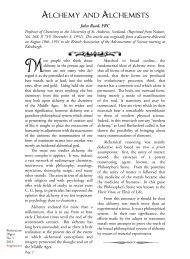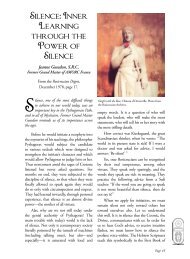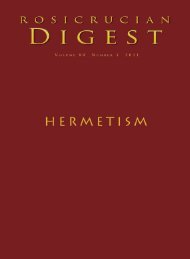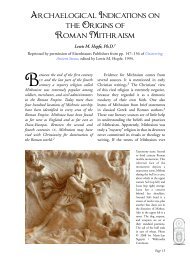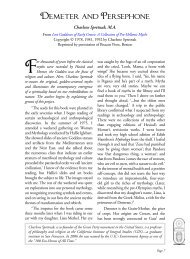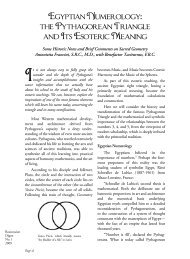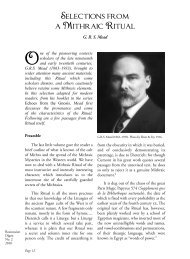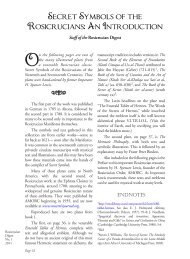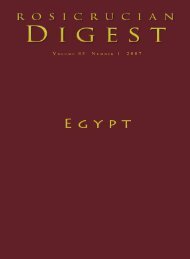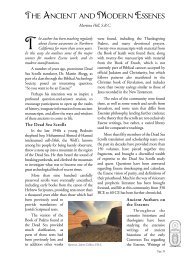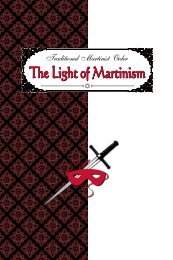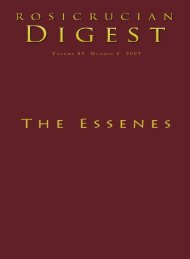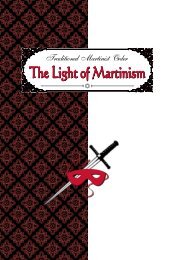Pythagorean Teachings across the Centuries - Rosicrucian Order
Pythagorean Teachings across the Centuries - Rosicrucian Order
Pythagorean Teachings across the Centuries - Rosicrucian Order
You also want an ePaper? Increase the reach of your titles
YUMPU automatically turns print PDFs into web optimized ePapers that Google loves.
The Seven Liberal Arts: Music and Pythagoras, fifteenth<br />
century, colored pen drawing. Salzburg University Library.<br />
respect to this, we are forced to discuss a<br />
somewhat unpleasant topic: <strong>the</strong> unlucky<br />
outcome of <strong>Pythagorean</strong>s in Italy.” To<br />
support this conclusion, he cites Dante,<br />
who, even if informed with discretion<br />
about <strong>the</strong> <strong>Pythagorean</strong> teachings, which he<br />
often quoted in his works, did not consider<br />
it wise to include Pythagoras among <strong>the</strong><br />
“philosophical family.”<br />
Even <strong>the</strong> early researchers of <strong>the</strong> Academy<br />
of Florence did not pay much attention<br />
to <strong>the</strong> contribution of Pythagoras as such,<br />
since <strong>the</strong>y were under <strong>the</strong> spell of Plato and<br />
Neoplatonism. 28 Never<strong>the</strong>less, under o<strong>the</strong>r<br />
names, <strong>the</strong> tradition continued unabated.<br />
There were outstanding exceptions to<br />
this, in both <strong>the</strong> Medieval and Renaissance<br />
periods. One was Leonardo of Pisa, known<br />
to history as Fibonnaci (ca. 1170-ca. 1250).<br />
Clearly inspired by Pythagoras, he is best<br />
known today for:<br />
• “The spreading of <strong>the</strong> Hindu-<br />
Arabic numeral system in Europe,<br />
primarily through <strong>the</strong> publication<br />
in <strong>the</strong> early thirteenth century of<br />
his Book of Calculation, <strong>the</strong> Liber<br />
Abaci. 29<br />
• “A number sequence named<br />
after him known as <strong>the</strong> Fibonacci<br />
numbers, which he did not discover<br />
but used as an example in <strong>the</strong> Liber<br />
Abaci. 30<br />
“In <strong>the</strong> Fibonacci sequence of numbers,<br />
each number is <strong>the</strong> sum of <strong>the</strong> previous<br />
two numbers, starting with 0 and 1. Thus<br />
<strong>the</strong> sequence begins 0, 1, 1, 2, 3, 5, 8, 13,<br />
21, 34, 55, 89, 144, 233, 377, 610 etc.<br />
The higher up in <strong>the</strong> sequence, <strong>the</strong> closer<br />
two consecutive Fibonacci numbers of <strong>the</strong><br />
sequence divided by each o<strong>the</strong>r will approach<br />
<strong>the</strong> golden ratio (approximately 1 : 1.618 or<br />
0.618 : 1).” 31<br />
The golden ratio was known to <strong>the</strong><br />
Egyptians and o<strong>the</strong>r ancient mystery schools,<br />
and is often found in natural structures.<br />
It was widely used in Renaissance art. It<br />
stands to reason that Pythagoras, with<br />
Egyptian, Middle Eastern, and Central Asian<br />
connections, would have understood this as,<br />
perhaps, part of his advanced curriculum.<br />
The brilliant work of Fibonacci, as well<br />
as <strong>the</strong> Boëthian foundations of <strong>the</strong> whole<br />
educational system of <strong>the</strong> Western Middle<br />
Ages, insured that <strong>Pythagorean</strong> ideas would<br />
be transmitted in many forms.<br />
With <strong>the</strong> great philosophers of <strong>the</strong><br />
Renaissance, <strong>the</strong>re is a new evaluation of <strong>the</strong><br />
A Fibonacci spiral created by drawing arcs connecting <strong>the</strong><br />
opposite corners of squares in <strong>the</strong> Fibonacci tiling, using<br />
squares of sizes 1, 1, 2, 3, 5, 8, 13, 21, and 34. 32<br />
Page xxxv




